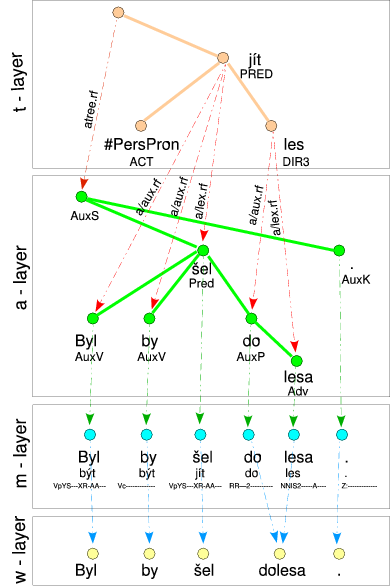Deep Syntax: Difference between revisions
No edit summary |
No edit summary |
||
| Line 9: | Line 9: | ||
== Functional Generative Description == | == Functional Generative Description == | ||
The functional generative description (FGD) is a linguistic theory developed by Petr Sgall in Prague in the 1960's. It formally describes the language as a system of layers, ranging from the most basic layers (phonology) to abstract ones (deep syntax/semantic -- the ''tectogrammatical layer''). The theory was developed with the intention to capture the language using a computer and indeed, much of the theory has been implemented as computer programs. However, the system of layers was gradually simplified and currently, only four layers are used (we refer to the annotation scheme for the Prague Dependency Treebank). An example of the layered description is shown on the following image (taken from PDT-2.0 documentation): | The functional generative description (FGD) is a linguistic theory developed by Petr Sgall in Prague in the 1960's. It formally describes the language as a system of layers, ranging from the most basic layers (phonology) to abstract ones (deep syntax/semantic -- the ''tectogrammatical layer''). The theory was developed with the intention to capture the language using a computer and indeed, much of the theory has been implemented as computer programs. However, the system of layers was gradually simplified and currently, only four layers are used (we refer to the annotation scheme for the Prague Dependency Treebank). | ||
== Prague Dependency Treebank == | |||
The Prague Dependency Treebank (PDT) is a corpus of Czech sentences manually annotated according to the FGD. An example of the layered description is shown on the following image (taken from PDT-2.0 documentation): | |||
[[File:i-layer-links.png|300px]] | [[File:i-layer-links.png|300px]] | ||
| Line 15: | Line 19: | ||
The lowest layer contains the sentence "as is", without any annotation. The m-layer provides a morphological analysis for each word (and also fixes typing errors). The a-layer is a dependency tree which describes the surface syntax of the sentence. Finally, the t-layer is a more abstract dependency tree which describes the deep syntax of the sentence. | The lowest layer contains the sentence "as is", without any annotation. The m-layer provides a morphological analysis for each word (and also fixes typing errors). The a-layer is a dependency tree which describes the surface syntax of the sentence. Finally, the t-layer is a more abstract dependency tree which describes the deep syntax of the sentence. | ||
== | == VALLEX == | ||
One of the central notions in FGD and PDT is (verb) valency. Essentially, valency is the ability of verbs to require arguments (for example, most verbs require an actor, or subject, only some require an object etc.) VALLEX is a fine-grained valency dictionary of Czech verbs. The assumption underlying this dictionary is that different ''valency frames'' roughly correspond to different verb senses. | |||
== MT Using Deep Syntax: TectoMT == | == MT Using Deep Syntax: TectoMT == | ||
Revision as of 14:03, 7 October 2015
 | |
| Lecture video: |
web TODO Youtube |
|---|---|
{{#ev:youtube|https://www.youtube.com/watch?v=lJwCW2mFk2M&index=11&list=PLpiLOsNLsfmbeH-b865BwfH15W0sat02V%7C800%7Ccenter}}
Functional Generative Description
The functional generative description (FGD) is a linguistic theory developed by Petr Sgall in Prague in the 1960's. It formally describes the language as a system of layers, ranging from the most basic layers (phonology) to abstract ones (deep syntax/semantic -- the tectogrammatical layer). The theory was developed with the intention to capture the language using a computer and indeed, much of the theory has been implemented as computer programs. However, the system of layers was gradually simplified and currently, only four layers are used (we refer to the annotation scheme for the Prague Dependency Treebank).
Prague Dependency Treebank
The Prague Dependency Treebank (PDT) is a corpus of Czech sentences manually annotated according to the FGD. An example of the layered description is shown on the following image (taken from PDT-2.0 documentation):
The lowest layer contains the sentence "as is", without any annotation. The m-layer provides a morphological analysis for each word (and also fixes typing errors). The a-layer is a dependency tree which describes the surface syntax of the sentence. Finally, the t-layer is a more abstract dependency tree which describes the deep syntax of the sentence.
VALLEX
One of the central notions in FGD and PDT is (verb) valency. Essentially, valency is the ability of verbs to require arguments (for example, most verbs require an actor, or subject, only some require an object etc.) VALLEX is a fine-grained valency dictionary of Czech verbs. The assumption underlying this dictionary is that different valency frames roughly correspond to different verb senses.
